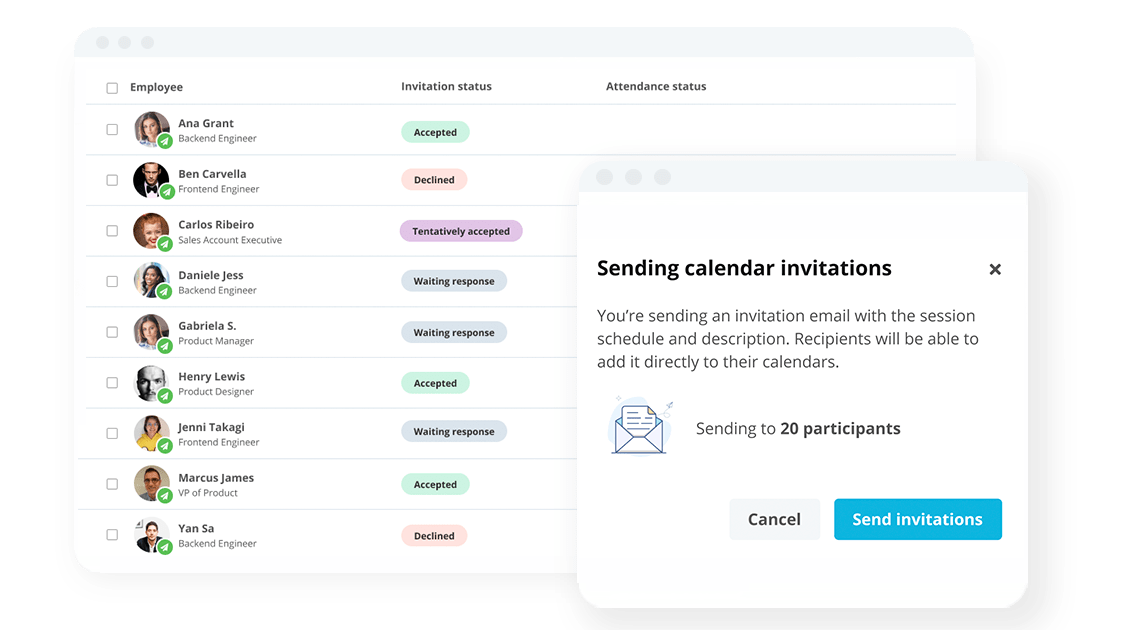
Give the Right Training at the Right Time
Simplify your staff development with centralised training management.
Latest Blog Posts
Conduct a Skills Audit Based On These 8 Reasons

Your team isn’t the same as it was five years ago—or even one year ago. And that’s a good thing.
To experience positive growth, your team needs to evolve, and so do their skills. By conducting a skills audit, you can keep on top of the industry while becoming more engaged, agile, and innovative. Here’s how.
Focus on your top talent’s skills with our Performance Management Guide.What Is A Skills Audit?
A skills audit is used to assess an employee’s capabilities in relation to their overall role. These assessments typically come in the form of a self-guided survey, a questionnaire or an interview.
From your organisation’s skills audit, you can start to take some key steps in the performance management process:
Identify an employee’s skill gap
Build out a skills matrix
Build a training needs analysis
Create customised learning and development (L&D) programs
If we look at it from the lens of overall talent management, a skills audit is not simply a way to identify where talent falters, but a way to sketch out a ‘map of potential’ of where things could go.
This offers a clear benefit not only to the people that work in your organisations but the managers they report to, and your business’s bottom line, in general.
When Should You Perform A Skills Audit?
In many organisations, employees’ roles and responsibilities are constantly changing to keep up with the industry and emerging technologies. With that in mind, it’s best to use skills audits as an ongoing practise to ensure your team retains and expands on established skills.
However, there are also a few key scenarios where conducting a skills audit is especially helpful, such as:
When your employees aren’t hitting their performance targets.
When you’re creating a new role and need to define the skills and attributes of an ideal hire.
When an employee is changing roles or departments and you need to identify their current strengths and weaknesses.
When an upcoming project requires specialized skills and you need to identify the most competent team member(s) for the job.
As part of your annual employee performance development review plan.
Skills Gaps: What Are They And How Do You Identify Them?
A skills gap is the difference between the level of skill an organisation expects from their employee and the level of skill the employee holds. The employee could be missing a skill altogether, or their knowledge could be outdated.
When an employee has a skills gap, they may not perform their duties successfully or to the degree of expertise needed to help the organization thrive.
Skills gaps are a common problem for teams, with 87% of companies claiming to experience them in some form. To identify an employee’s skills gap, use a skills audit to assess their capabilities and compare the results to the amount of skill you expect from their role.
Some common skills gaps in many organisations include:
Critical thinking skills
Leadership or mentorship
Attention to detail or diligence
Communication or teamwork skills
Develop Staff With Ease

Track training attendance, progress and compliance across your organisation from one central, easy-to-use tool.
8 Advantages Of Conducting A Skills Audit
As a manager or leader, you can overcome some of your most frequent (and headache-inducing) obstacles by conducting skills audits.
These assessments give you the insights you need to identify ‘why’ behind lagging employee performance, stop the revolving door of unsuccessful new hires and feel prepared for the future of work.
Here’s what else you’ll gain:
1. Your Employees And Roles Will Be Correctly Matched
Every role changes over time. Through a skills audit, you can determine if an employee still possesses (or can gain) the necessary skills for their role. You may also uncover previously unidentified skills, which qualify the employee for a better-suited position.
2. Your Team Will Be Future-Proof
No matter how the world changes, conducting a skills audit can make your team more agile and innovative. But, it requires getting ahead of the issues before they become issues.
For example, say you conduct a skills audit for a team and discover that only one employee is capable of using certain software. You’d then want to train all the other team members on that same platform. So, if that original employee is away, on sick leave or leaves the company, your team won’t suffer from a skills gap.
3. Your Team’s Skills And Goals Will Align
When was the last time you compared your organisation’s goals with your team’s skills? Over time, the two can drift further and further apart, leading to stagnant employee performance and minimal organisational growth.
When auditing an employee’s skills, consider their role and how it correlates to your team’s goals.
For example, an Events Operations Manager may have joined your team with the expectation (and skills) to run on-site events and conferences. But then, they had to shift their approach and create online events that are just as engaging and interactive.
To bridge this potential skills gap, the employee may need additional technical support or training to do their job effectively and help their team achieve their goal.
4. You’ll Easily Identify And Prioritise Training Needs
Instead of having employees complete standard learning and development courses, skills audits will help you identify and prioritise your employees’ unique learning needs.
From there, you can create more effective training solutions that make the best use of your time, budget, and resources.
5. You’ll Uncover Patterns And Training Opportunities
After conducting and reviewing your skills audits, you may uncover a pattern of underdeveloped skills in certain demographics or groups.
For example, suppose you see several of your employees in a specific department lack the same skills. In that case, that implies you’re either not hiring the right candidates, not including the right requirements in your job advertisements, or your onboarding/employee training needs to be revised.
6. You’ll Improve Employee Attraction And Acquisition
Once you uncover those patterns, you can use that information to improve your job adverts and attract more qualified candidates for the position.
Use the skills audits to determine the most important skills for the job, and if new skills are needed due to a change in duties/responsibilities within that role. If you’re hiring for a newly-created position, include skills that will fill the skills gaps of other team members.
7. You’ll Streamline Succession Planning
What skills and traits do great leaders hold? A skills audit can tell you, and better yet, it can help you identify those same traits in other potential leaders so you can build a succession plan to nurture them in their careers.
8. You’ll Strengthen Engagement And Retention
Ninety-four per cent of employees say they would stay at a company longer if they invested in career development. After you complete a skills audit, you can provide the training, resources, and support for employees to become experts in their role, gain more confidence and become more engaged in their work.
How To Conduct A Proper Skills Audit
Skills audits are a joint venture. They’re crafted to gain an employee’s perspective and understanding of their role, validated by their manager or supervisor, and used to support the growth of both the individual and the organisation.
Here’s a seven-step process you can use to design and implement your next skills audit:
1. Goal Setting and Preparation
First, meet with your leadership or management team to get their approval on the resources, investment and time needed to create, implement and action your skills audits.
During this time, identify your organisation’s goals and targets for the coming year (or beyond). These goals will inform your HR strategy, subsequent skills audit and the action steps you take afterwards.
2. Lead With Transparency
Before you survey, interview and audit your employees, tell them the purpose of the audit and how their cooperation will impact their role. Some employees may fear for their job security if they’re open about their struggles, so maintaining communication and support is crucial.
3. Define Job Competencies
To avoid overwhelm, focus on one position or department at a time. Review current job descriptions for the role(s) you’re auditing to ensure they’re up to date and all skills/requirements are relevant.
Review the descriptions with the department head to see if anything is missing, if they regularly assign their team members duties that aren’t listed or if some tasks are outdated.
Have the same conversation with the employee(s) in that role. Determine if any duties aren’t listed in the original job description, identify irrelevant tasks/responsibilities and if there are any new qualifications, certifications or skills they’ve learned since taking on their role.
4. Design Your Audit
Whether you provide self-assessments or conduct one-on-one interviews, the goal of the audit is to gain the employee’s perspective on their skill level, how they view the skill in relation to their work, and an example of how they use that skill.
Here’s an outline of what you can include in each audit:
The Basics
Employee Name
Role
Training History
The Skill And Subskills Under Audit
For example, if Organisation is the skill, subskills could include planning, time management and prioritizing tasks.
Rating: How Relevant The Skill Is To Their Role
Unimportant
Useful
Essential
Significant
Rating: Their Knowledge Of That Skill
None
Basic
Average
Expert
Evidence
Proof of their expertise in that skill or what they can improve.
5. Survey Employees
Have employees conduct a self-assessment of the audit above so they can identify their own strengths, weaknesses and areas of improvement.
6. Validate The Information
Self-assessments may be clouded by the individual’s perception of their skills, whether they believe their skills are worse or better than they actually are.
To minimise this bias, have the relevant supervisor/manager conduct the same audit for the employee and compare the results.
You can also gain a more comprehensive understanding of an employee’s skills by looking at past performance reviews, collecting client/customer/peer reviews and seeing what training they’ve completed.
7. Review And Analyse
Review the self-audits, manager/supervisor audits, and other data to identify the employee’s skills gaps and determine your next steps.
After The Audit: 4 Action Steps To Move Your Team Forward
With the audits completed and skills gaps identified, there’s no way but up. The next step is to guide the employee through a supportive process of celebrating their strengths and improving their abilities.
Enrol Employees In A Upskilling Or Reskilling Program
Conduct a training needs analysis to create a customised learning path for the employee so they can fill in their skills gaps. This may include a reskilling program if they’re changing roles or require training that replaces or updates their current knowledge of a topic.
Other employees may require upskilling. This training doesn’t necessarily replace outdated knowledge but instead expands on their knowledge or skills.
Partner Employees With A Mentor Or Coach
Coaching and mentorship programs are highly effective when helping an employee improve soft skills such as problem-solving, listening or communication. It can also encourage self-improvement and provide daily accountability and support during the training period.
Start Leadership Training
If an employee needs little upskilling/reskilling, has outgrown their role, or has voiced the desire to move up in the organization, start them on a succession plan or begin leadership development.
Expand The Team
Consider if you need to expand your team with new employees or roles. This may be necessary to fill a skills gap, replace a team member who is being promoted or support the team while they complete their needed training.

